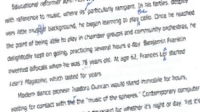Whether you're a business
owner or nonprofit head who wants to promote
your offerings with dignity or a copywriter
troubled by the prevalence of exaggerated,
over-the-top writing on the Web, you're
wondering whether it's possible for
marketing copy to nail the sale without
overheated language and without stretching
of the truth. The answer is yes.
If a carnival-barker tone,
overheated language and stretching of the
truth bother you, you can still nail the
sale with dignity and measured drama. There
are plenty of honest, effective copywriting
techniques with which to stock up your
promotional toolbox. Use these five no-hype
techniques to perk up your marketing while
keeping you out of the gutter.
1. Story telling. A
true tale with dramatic happenings attracts
and holds a reader's attention and can
illustrate a general point vividly. For
example, I might describe receiving tubs
full of envelopes at the Back Bay post
office in Boston and opening them with my
husband on the floor of our apartment. Each
envelope contained either a $2 check or two
$1 bills, which we stacked in piles that got
so high that they tipped over. (This
happened in the early 1990s.)
Anecdotes with this kind
of specific detail brings reality to life
for readers, more so than an abstract
summary like "It's fun to make money" or
ungrounded promises like "Your neighbors
will gossip that you must have won the
lottery." A story can be about you, about
someone who experienced what you're selling
or even about a historical figure.
|
Learn From the
Masters of No-Hype Copywriting
In 2013 and 2014, Marcia Yudkin
convened the most articulate and
experienced practitioners of no-hype
copywriting for an exchange of ideas
on writing copy that persuades
without excessive showmanship or
stretching the truth.
Presenters included Peter Bowerman,
Nick Usborne, Shel Horowitz, Karon
Thackston and others.
Order the
recordings from this telesummit. |
2. Before and after.
For greater impact, writing teachers have
always advised, "Show, don't tell." Hardly
anything convinces more than using words or
pictures (or both) to show the situation
prior to the application of the service or
product you're selling, then the situation
afterwards. In using photos, realize that
you may also need verbal description,
because without commentary, the uneducated
eye may not see the dramatic differences
that a professional notices immediately.
3. Creative touches.
Whereas hypesters use outlandish and
inflammatory metaphors, you can spice up
your presentation with the same techniques,
but used sparingly and gracefully as an aid
to the imagination and understanding rather
than as extreme promises. For instance, an
executive coach pitched his services for
corporate leaders as helping them "navigate
the seas of change": "organizations need
leaders who know how to survive stormy seas
and avoid hidden reefs and icebergs." The
design also accentuated the nautical theme
with images of compasses, and the overall
tone was restrained and professional.
4. Skillful use of
language. Did you notice the wordplay
above in "techniques that perk up your
marketing while keeping you out of the
gutter"? The words "perk" and "keep" contain
the same pair of consonants, but in reverse
order, which pleases the reader's ear.
Another guideline: Never
use an abstract expression when you can
instead create an image in the reader's
mind. Reach especially for language that
gives readers something to hear, see or
touch in their mind. For instance, my bio
doesn't say I was published often in
magazines but rather, "her bylines in
national magazines on journalistic and
opinion pieces began piling up." Such
concrete wording imparts vigor and energy to
your marketing.
 |
Improve Your
Proofreading
Quick online course teaches how to
catch pesky typos. Whether you check
writing on screen or on paper, learn the
stakes for error-ridden copy, the five
best proofreading methods and the tools
you can or shouldn't use to identify
errors. Includes practice tests and
answers.
Proofreading Hacks course. |
Orchestrating phrases the
way expert speechwriters do (as in "of the
people, by the people, for the people") is
one more way to give your presentation
balance and finesse.
5. Proof. This
element can set you most decisively apart
from those relying on hype. Provide evidence
that what you are selling does what it
promises to do, and more. Your evidence
might consist of client testimonials,
third-party endorsements, media coverage,
scientific research results, credentials,
case studies, client surveys, referral
statistics, descriptive details that only
someone immersed in your work would have and
why-it-works explanations. All of these
persuade to the extent that they are firmly
and frankly grounded in reality.
To avoid hype, be truthful
and vivid. You'll thereby keep the reader
awake, connect with the reader's
imagination, quash skepticism and arouse the
reader's desire to buy.





